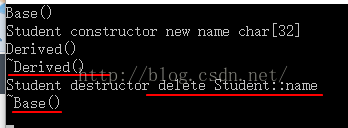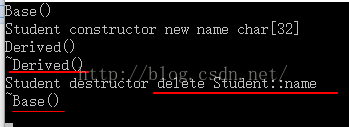關於c++類中的虛析構函數。我得出如下3點結論
1.所有基類的析構函數,都應該聲明為虛析構函數!這也是c++標准所指定的。
非繼承類的析構函數執行會有如下操作:
1、執行析構函數中的代碼
2、如果所在類有成員變量(類對象),再執行類成員變量的析構函數
普通析構函數:
以如下代碼為例
class Student
{
public:
Student()
{
name = new char[32];
cout << "Student constructor new name char[32]" << endl;
}
~Student()
{
delete name;
cout << "Student destructor delete Student::name" << endl;
}
private:
char* name;
};
class Normal
{
public:
Student stu;
Normal(){cout << "Normal constructor" << endl;}
~Normal(){cout << "Normal destructor" << endl;}
};
int main()
{
Normal* pn = new Normal();
delete pn;
return 0;
}執行結果:

(表示很討厭上面的水印)
析構順序:
1、執行析構函數中的代碼
2、如果所在類有成員變量(類對象),再執行類成員變量的析構函數
以上內容很好理解,因為只是單個類對象的析構,當然也關系到類的組合。
接下來我想討論的是存在繼承關系時,析構函數在做些什麼?
#include
using namespace std;
#include
class Student
{
public:
Student()
{
name = new char[32];
cout << "Student constructor new name char[32]" << endl;
}
~Student()
{
delete []name;
cout << "Student destructor delete Student::name" << endl;
}
private:
char* name;
};
class Base
{
public:
Base()
{
cout << "Base()" << endl;
}
~Base()
{
cout << "~Base()" << endl;
}
};
class Derived:public Base
{
public:
Derived()
{
cout << "Derived()" << endl;
}
~Derived()
{
cout << "~Derived()" << endl;
}
Student stu;
};
int main()
{
Derived *pd = new Derived();
delete pd;
return 0;
}
執行結果:

派生類對象的析構過程:
1,調用派生類對象的析構函數,
2,調用派生類中成員對象的析構函數
3,調用基類的析構函數
-------------------------------------我是丑陋的分割線-------------------------------------------
在分割線的上方,一切正常,沒有什麼特別的,異樣的地方。
接下來要討論的是多態情況下的析構函數。
#include
using namespace std;
#include
class Student
{
public:
Student()
{
name = new char[32];
cout << "Student constructor new name char[32]" << endl;
}
~Student()
{
delete []name;
cout << "Student destructor delete Student::name" << endl;
}
private:
char* name;
};
class Base
{
public:
Base()
{
cout << "Base()" << endl;
}
~Base()
{
cout << "~Base()" << endl;
}
};
class Derived:public Base
{
public:
Derived()
{
cout << "Derived()" << endl;
}
~Derived()
{
cout << "~Derived()" << endl;
}
Student stu;
};
int main()
{
Base* pb = new Derived(); // 注意這一行,基類指針指向了派生類
delete pb; // delete 基類指針
return 0;
}
執行結果:

只調用基類的析構函數,派生類的析構函數沒有被調用,更要注意的是,因此派生類的成員對象也沒有被析構,缺少了“Student destructor delete Student::name”
所以會有內存洩漏。
如下代碼也會出現內存洩漏:
class Base
{
};
class Derived:public Base
{
public:
string str; // 這種內存洩漏就不容易發現了!!!
};
int main()
{
Base* pb = new Derived(); // 派生類的string對象會發生內存洩漏!
delete pb;
return 0;
}
如上類繼承時發生的內存洩漏,如何解決?
只需要將基類的析構函數聲明為虛析構函數,就是前面加上virtual.
#include
using namespace std;
#include
class Student
{
public:
Student()
{
name = new char[32];
cout << "Student constructor new name char[32]" << endl;
}
~Student()
{
delete []name;
cout << "Student destructor delete Student::name" << endl;
}
private:
char* name;
};
class Base
{
public:
Base()
{
cout << "Base()" << endl;
}
virtual ~Base()
{
cout << "~Base()" << endl;
}
};
class Derived:public Base
{
public:
Derived()
{
cout << "Derived()" << endl;
}
~Derived()
{
cout << "~Derived()" << endl;
}
Student stu;
};
int main()
{
Base* pb = new Derived();
delete pb;
return 0;
}
 發現一切OK了。
發現一切OK了。
總結:
1.所有基類的析構函數,都應該聲明為虛析構函數!這也是c++標准所指定的。
2.如果設計一個類,可能會被後來的其他類所繼承,我們一定要將它的析構函數聲明為虛析構。否則被繼承會出現內存洩漏等意想不到的問題。
3.如果我們要去繼承另外一個類,首先一點是要保證被繼承的類的析構函數已經聲明為了虛析構函數!